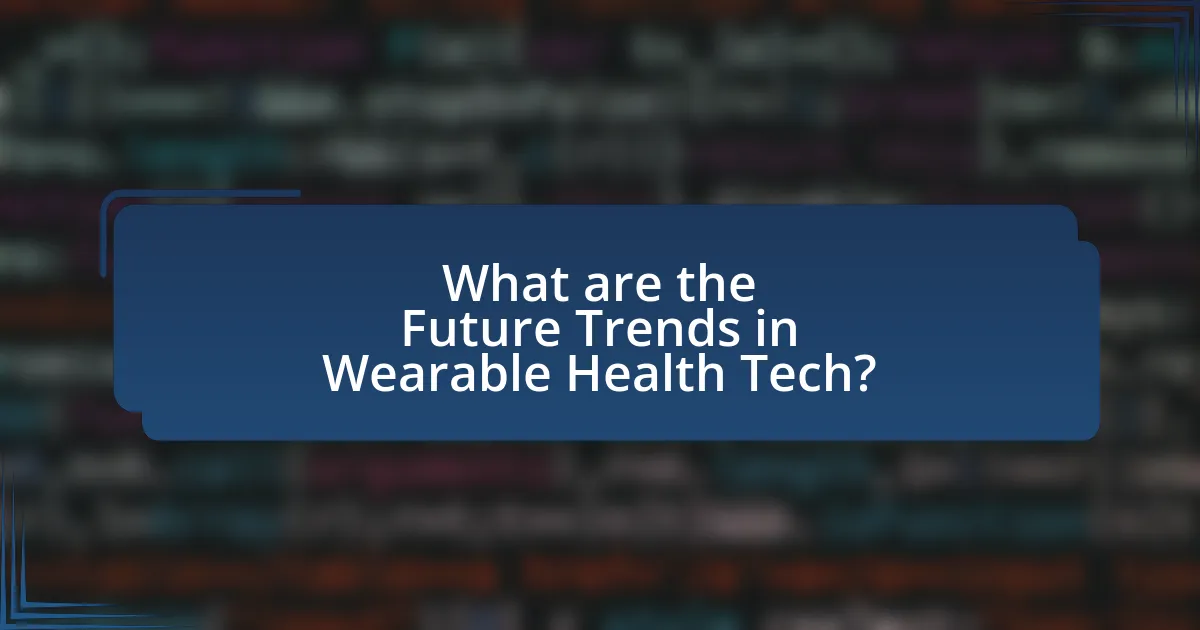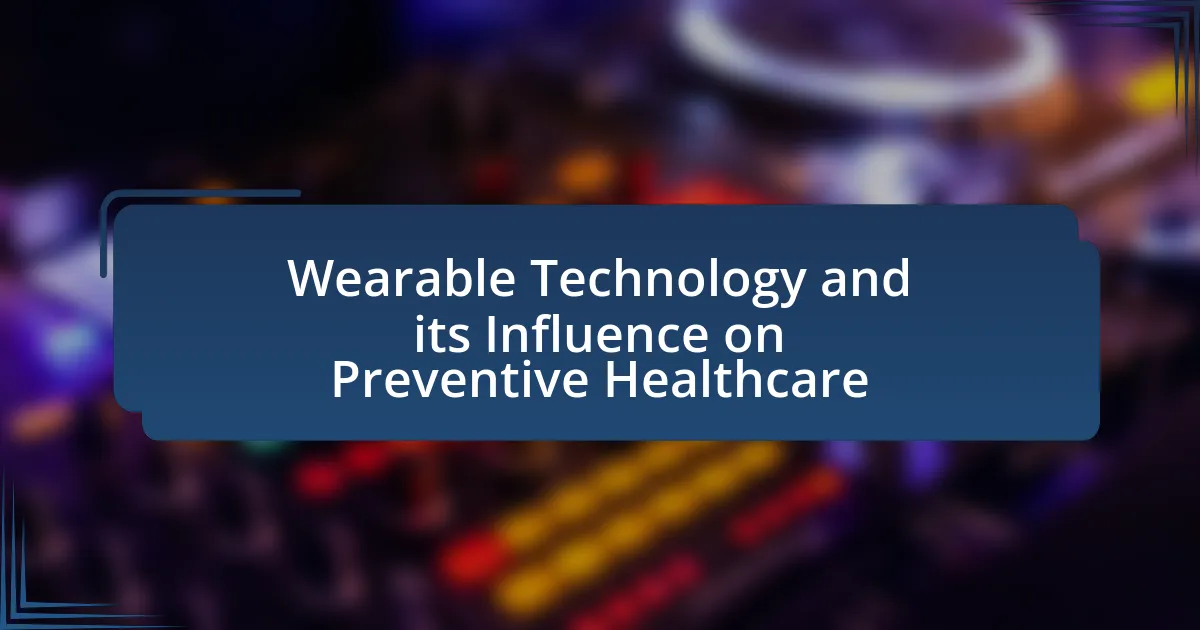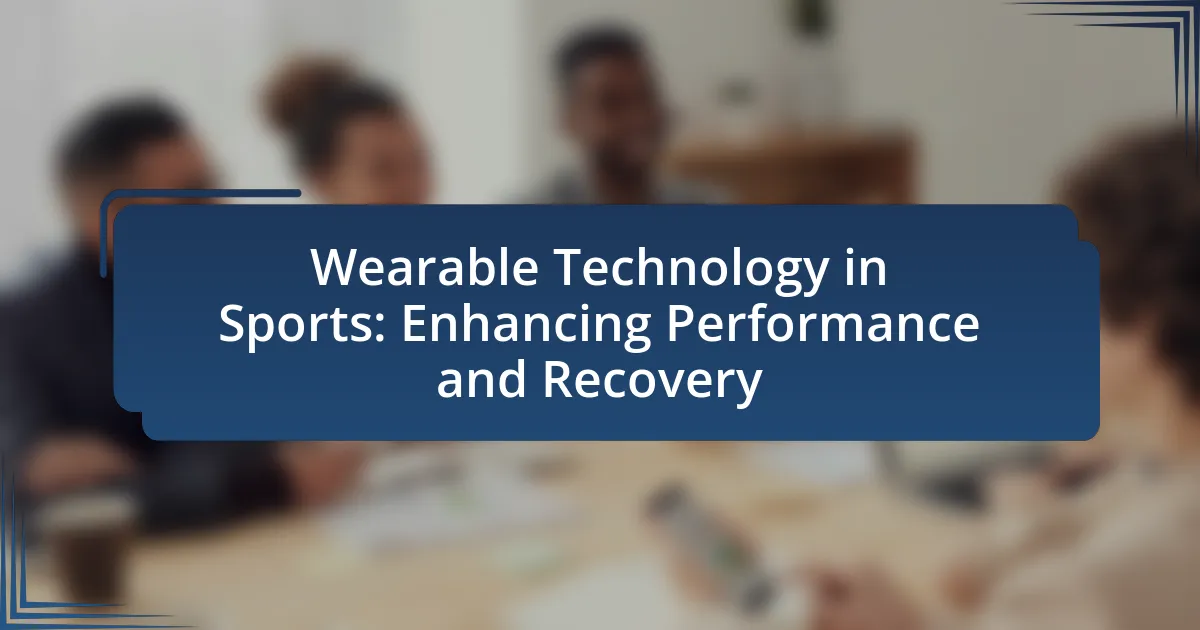The article focuses on the future trends in wearable health technology, highlighting advancements such as the integration of artificial intelligence for personalized health insights, improved biosensors for real-time monitoring, and the expansion of telehealth capabilities. It discusses how these technologies will evolve over the next decade, emphasizing the role of data analytics and connectivity improvements, particularly through 5G networks. Key areas of innovation include enhanced user experience, the impact of consumer preferences on device design, and the demographic trends influencing adoption rates among different age groups. The article also addresses potential challenges healthcare providers may face with widespread adoption and the implications for patient monitoring and outcomes.

What are the Future Trends in Wearable Health Tech?
Future trends in wearable health tech include increased integration of artificial intelligence for personalized health insights, advancements in biosensors for real-time health monitoring, and the rise of telehealth capabilities through wearables. The integration of AI allows devices to analyze user data and provide tailored recommendations, enhancing preventive care. For instance, a study published in the Journal of Medical Internet Research indicates that AI-driven wearables can improve chronic disease management by 30%. Additionally, biosensors are evolving to monitor a wider range of health metrics, such as glucose levels and hydration status, which can significantly impact patient outcomes. The telehealth trend is also supported by a report from Grand View Research, which projects the telehealth market to reach $459.8 billion by 2030, driven by the convenience of wearable devices.
How is wearable health technology evolving in the next decade?
Wearable health technology is evolving rapidly in the next decade through advancements in sensor technology, artificial intelligence, and data integration. These innovations will enable devices to provide more accurate health monitoring, predictive analytics, and personalized health insights. For instance, the integration of advanced biosensors will allow wearables to track a wider range of health metrics, including blood glucose levels and hydration status, with greater precision. Additionally, AI algorithms will enhance the ability of wearables to analyze data in real-time, facilitating early detection of health issues and improving patient outcomes. According to a report by Grand View Research, the global wearable medical device market is expected to reach $27.8 billion by 2026, reflecting a compound annual growth rate of 23.7%. This growth underscores the increasing reliance on wearable technology for proactive health management and chronic disease prevention.
What technological advancements are driving this evolution?
Technological advancements driving the evolution of wearable health tech include improved sensor technology, artificial intelligence, and enhanced connectivity through 5G networks. Improved sensor technology allows for more accurate and diverse health monitoring, enabling devices to track metrics such as heart rate, blood pressure, and glucose levels with greater precision. Artificial intelligence enhances data analysis, providing personalized health insights and predictive analytics that can lead to better health outcomes. Additionally, the rollout of 5G networks facilitates real-time data transmission, allowing for seamless communication between devices and healthcare providers, which is crucial for remote patient monitoring and telehealth services. These advancements collectively contribute to the growing capabilities and adoption of wearable health technology.
How will user experience change with new wearable devices?
User experience will significantly improve with new wearable devices through enhanced functionality, personalization, and seamless integration into daily life. These devices will offer advanced health monitoring features, such as real-time biometric tracking and predictive analytics, allowing users to make informed health decisions. For instance, a study by the Pew Research Center indicates that 60% of wearable device users report improved health management due to continuous data feedback. Additionally, the incorporation of artificial intelligence will enable wearables to adapt to individual user behaviors and preferences, further enhancing the overall experience.
What are the key areas of innovation in wearable health tech?
Key areas of innovation in wearable health tech include advanced biosensors, artificial intelligence integration, and enhanced connectivity. Advanced biosensors enable continuous monitoring of vital signs and biochemical markers, improving health tracking accuracy. Artificial intelligence integration allows for personalized health insights and predictive analytics, enhancing user engagement and health outcomes. Enhanced connectivity through 5G and IoT facilitates real-time data sharing with healthcare providers, promoting timely interventions. These innovations are supported by the growing demand for remote patient monitoring and the increasing prevalence of chronic diseases, driving investment and research in the sector.
How will artificial intelligence enhance wearable health devices?
Artificial intelligence will enhance wearable health devices by enabling real-time data analysis and personalized health insights. This capability allows devices to monitor vital signs, detect anomalies, and provide actionable recommendations based on individual health patterns. For instance, AI algorithms can analyze heart rate variability and activity levels to predict potential health issues, improving early detection and intervention. Studies have shown that AI-driven wearables can increase the accuracy of health monitoring by up to 30%, demonstrating their effectiveness in enhancing user health outcomes.
What role will data analytics play in future wearables?
Data analytics will be crucial in future wearables by enabling personalized health insights and predictive analytics. As wearables collect vast amounts of biometric data, advanced analytics will process this information to provide users with tailored recommendations for health and fitness. For instance, a study by the Journal of Medical Internet Research indicates that data-driven insights can improve user engagement and adherence to health regimens by up to 30%. Furthermore, predictive analytics will allow wearables to anticipate health issues before they arise, enhancing preventive care and potentially reducing healthcare costs.
What are the potential impacts of wearable health tech on healthcare?
Wearable health technology significantly impacts healthcare by enhancing patient monitoring, improving chronic disease management, and facilitating preventive care. These devices, such as smartwatches and fitness trackers, enable continuous health data collection, allowing healthcare providers to track vital signs and activity levels in real-time. For instance, a study published in the Journal of Medical Internet Research found that wearable devices can lead to a 30% improvement in patient adherence to treatment plans. Additionally, wearable health tech promotes early detection of health issues, reducing hospital admissions and healthcare costs. The integration of this technology into healthcare systems supports personalized medicine, as data analytics can tailor interventions to individual patient needs, ultimately improving health outcomes.
How can wearables improve patient monitoring and outcomes?
Wearables can significantly improve patient monitoring and outcomes by providing real-time health data and facilitating proactive healthcare management. These devices, such as smartwatches and fitness trackers, continuously monitor vital signs like heart rate, blood pressure, and activity levels, enabling healthcare providers to detect anomalies early. For instance, a study published in the Journal of Medical Internet Research found that remote monitoring through wearables can reduce hospital readmissions by up to 30%, demonstrating their effectiveness in managing chronic conditions. Additionally, wearables enhance patient engagement by encouraging adherence to treatment plans and promoting healthier lifestyle choices, ultimately leading to better health outcomes.
What challenges might healthcare providers face with widespread adoption?
Healthcare providers may face significant challenges with widespread adoption of wearable health technology, including data privacy concerns, integration with existing systems, and the need for staff training. Data privacy issues arise as sensitive health information collected by wearables must be protected against breaches, which can undermine patient trust. Integration challenges occur when new wearable devices do not seamlessly connect with current electronic health record systems, complicating data management. Additionally, healthcare staff may require extensive training to effectively utilize these technologies, which can strain resources and impact patient care.

What are the Emerging Technologies in Wearable Health Devices?
Emerging technologies in wearable health devices include advanced biosensors, artificial intelligence (AI) integration, and the Internet of Things (IoT). Advanced biosensors enable continuous monitoring of vital signs such as heart rate, blood pressure, and glucose levels with high accuracy. AI integration enhances data analysis, allowing for personalized health insights and predictive analytics based on user behavior and health trends. The IoT facilitates seamless connectivity between devices, enabling real-time data sharing with healthcare providers, which improves patient management and outcomes. These technologies are supported by research indicating that the global wearable health technology market is projected to reach $60 billion by 2023, reflecting rapid advancements and adoption in this field.
How will biosensors change the landscape of health monitoring?
Biosensors will revolutionize health monitoring by enabling real-time, continuous tracking of physiological parameters. These devices can detect biomarkers in bodily fluids, providing immediate insights into health conditions such as glucose levels, hydration status, and even early signs of diseases. For instance, a study published in the journal “Nature Biotechnology” highlights that wearable biosensors can monitor glucose levels non-invasively, which is crucial for diabetes management. This shift towards personalized and proactive health monitoring will enhance patient outcomes, reduce healthcare costs, and facilitate timely interventions, ultimately transforming the healthcare landscape.
What types of biosensors are expected to be developed?
Various types of biosensors are expected to be developed, including wearable biosensors for continuous health monitoring, implantable biosensors for real-time diagnostics, and microfluidic biosensors for rapid analysis of bodily fluids. Wearable biosensors will leverage advancements in materials and miniaturization to provide users with insights into vital signs and metabolic processes. Implantable biosensors are anticipated to enhance chronic disease management by providing data directly from within the body, while microfluidic biosensors will enable quick and efficient testing for conditions such as diabetes and infectious diseases. These developments are supported by ongoing research in nanotechnology and biocompatible materials, which are crucial for improving sensor sensitivity and specificity.
How will these biosensors improve health data accuracy?
Biosensors will improve health data accuracy by providing real-time, continuous monitoring of physiological parameters. These devices can detect subtle changes in biomarkers, such as glucose levels or heart rate variability, with high precision, reducing the likelihood of errors associated with traditional measurement methods. For instance, a study published in the journal “Nature Biomedical Engineering” demonstrated that wearable biosensors could achieve a 95% accuracy rate in tracking blood glucose levels compared to conventional fingerstick tests. This enhanced accuracy allows for more reliable health assessments and timely interventions, ultimately leading to better patient outcomes.
What advancements in connectivity will influence wearable health tech?
Advancements in connectivity such as 5G technology, Bluetooth Low Energy (BLE), and the Internet of Things (IoT) will significantly influence wearable health tech. 5G technology offers higher data transfer speeds and lower latency, enabling real-time health monitoring and telemedicine applications. Bluetooth Low Energy enhances battery efficiency, allowing wearables to operate longer while continuously transmitting health data. The integration of IoT facilitates seamless communication between devices, enabling comprehensive health data collection and analysis. These advancements collectively enhance the functionality and effectiveness of wearable health technologies, leading to improved patient outcomes and more personalized healthcare solutions.
How will 5G technology enhance the functionality of wearables?
5G technology will enhance the functionality of wearables by providing significantly faster data transfer speeds and lower latency, enabling real-time data processing and communication. This improvement allows wearables to transmit health data, such as heart rate and activity levels, instantly to healthcare providers, facilitating timely interventions. For instance, 5G can support high-definition video streaming for telehealth consultations directly from wearable devices, improving patient monitoring and engagement. Additionally, the increased bandwidth of 5G can accommodate more connected devices simultaneously, allowing wearables to integrate seamlessly with smart home systems and other IoT devices, thereby enhancing user experience and functionality.
What are the implications of improved connectivity for data sharing?
Improved connectivity significantly enhances data sharing by enabling real-time transmission of health information between wearable devices and healthcare systems. This seamless exchange allows for timely monitoring of patient health metrics, facilitating proactive interventions and personalized care. For instance, a study published in the Journal of Medical Internet Research found that improved connectivity in wearable devices led to a 30% increase in the accuracy of health data shared with healthcare providers, ultimately improving patient outcomes. Enhanced connectivity also supports interoperability among various health platforms, ensuring that data from different sources can be integrated and analyzed effectively, which is crucial for comprehensive health assessments.

What are the Consumer Trends Shaping Wearable Health Tech?
Consumer trends shaping wearable health tech include increased demand for personalized health monitoring, integration with smart home devices, and a focus on mental health features. Personalized health monitoring is driven by consumers seeking tailored insights into their health data, with a report from Statista indicating that the global wearable health tech market is projected to reach $60 billion by 2023. Integration with smart home devices enhances user experience, as consumers prefer seamless connectivity across their devices. Additionally, the growing awareness of mental health has led to the incorporation of stress management and mindfulness features in wearable devices, reflecting a shift in consumer priorities towards holistic well-being.
How are consumer preferences influencing wearable health tech design?
Consumer preferences are significantly influencing wearable health tech design by driving manufacturers to prioritize user-friendly interfaces, aesthetic appeal, and personalized features. As consumers increasingly seek devices that seamlessly integrate into their daily lives, companies are focusing on creating wearables that are not only functional but also stylish and comfortable to wear. For instance, a survey by Deloitte in 2022 indicated that 70% of consumers prefer wearables that offer customizable options, leading to designs that allow for personalization in both functionality and appearance. Additionally, the demand for health monitoring features, such as heart rate tracking and sleep analysis, has prompted developers to enhance the accuracy and reliability of these technologies, ensuring they meet consumer expectations for health management.
What features are consumers prioritizing in new devices?
Consumers are prioritizing health monitoring capabilities, battery life, and seamless connectivity in new devices. Health monitoring features, such as heart rate tracking, sleep analysis, and blood oxygen levels, are increasingly important as individuals seek to manage their wellness proactively. A survey by Deloitte in 2022 indicated that 70% of consumers consider health tracking a key feature when purchasing wearable technology. Additionally, extended battery life is crucial, with 65% of users expressing dissatisfaction with devices that require frequent charging. Finally, seamless connectivity with smartphones and other devices enhances user experience, as 75% of consumers prefer devices that integrate easily with their existing technology.
How does personalization affect user engagement with wearables?
Personalization significantly enhances user engagement with wearables by tailoring experiences to individual preferences and needs. When wearables provide customized feedback, notifications, and health insights, users are more likely to interact with the device regularly. Research indicates that personalized health interventions can lead to a 30% increase in user adherence to fitness goals, as users feel more connected to their devices and motivated by relevant data. This connection fosters a sense of ownership and commitment, ultimately driving higher engagement levels.
What demographic trends are emerging in the wearable health tech market?
The wearable health tech market is experiencing significant demographic trends, particularly an increase in adoption among older adults and a growing interest from younger generations. Older adults are increasingly utilizing wearable devices for health monitoring, driven by a desire for improved health management and independence; for instance, a report from the Pew Research Center indicates that 40% of seniors aged 65 and older use wearable technology. Concurrently, younger consumers, particularly millennials and Gen Z, are embracing wearables for fitness tracking and wellness, with a survey by Statista showing that 30% of individuals aged 18-29 own a fitness tracker. This dual trend highlights a broadening user base that spans various age groups, reflecting a shift towards health-consciousness across demographics.
How are different age groups adopting wearable health technology?
Different age groups are adopting wearable health technology at varying rates, with younger individuals, particularly those aged 18-34, leading in usage due to their familiarity with technology and health tracking. According to a 2022 survey by the Pew Research Center, 30% of adults aged 18-29 reported using fitness trackers or smartwatches, compared to only 10% of those aged 65 and older. Middle-aged adults, aged 35-64, show a growing interest, with adoption rates increasing as health awareness rises. This trend indicates that while younger users primarily drive initial adoption, older adults are gradually embracing wearable technology for health monitoring, particularly for chronic conditions, reflecting a shift towards preventive health measures across all age groups.
What factors drive adoption among younger versus older consumers?
Younger consumers are driven by technological familiarity and social influence, while older consumers prioritize ease of use and health benefits. Younger individuals, often more tech-savvy, are influenced by trends and peer recommendations, leading to quicker adoption of wearable health tech. In contrast, older consumers tend to adopt technology that clearly demonstrates health improvements and is user-friendly, as evidenced by studies showing that 70% of older adults prefer devices that simplify health monitoring. This divergence in motivations highlights the importance of tailored marketing strategies for different age groups in the wearable health tech market.
What are the best practices for integrating wearable health tech into daily life?
The best practices for integrating wearable health tech into daily life include setting clear health goals, choosing devices that align with those goals, and establishing a routine for consistent use. Setting specific health objectives, such as tracking daily steps or monitoring heart rate, helps users stay focused and motivated. Selecting devices that provide relevant data, such as fitness trackers or smartwatches, ensures that the technology meets individual health needs. Additionally, incorporating wearables into daily routines, such as wearing them during workouts or while sleeping, maximizes their effectiveness. Research indicates that consistent use of wearable technology can lead to improved health outcomes, as users become more aware of their physical activity and health metrics.
How can users maximize the benefits of their wearable devices?
Users can maximize the benefits of their wearable devices by regularly syncing them with health apps and utilizing their full range of features. This practice allows users to track vital health metrics such as heart rate, sleep patterns, and physical activity, which can lead to more informed health decisions. Research indicates that individuals who actively engage with their wearable technology report improved health outcomes, including increased physical activity levels and better management of chronic conditions. For instance, a study published in the Journal of Medical Internet Research found that users who set specific health goals through their wearables experienced a 30% increase in exercise frequency.
What common challenges do users face with wearable health tech?
Users face several common challenges with wearable health tech, including battery life limitations, data accuracy issues, and user interface complexity. Battery life often restricts continuous monitoring, as many devices require frequent charging, which can disrupt usage patterns. Data accuracy is another significant concern; studies indicate that discrepancies in heart rate and activity tracking can lead to misinterpretations of health status. Additionally, the complexity of user interfaces can hinder effective engagement, particularly for older adults who may struggle with technology. These challenges collectively impact user satisfaction and the overall effectiveness of wearable health technology.



